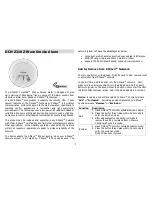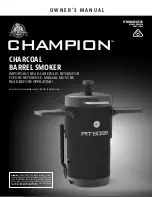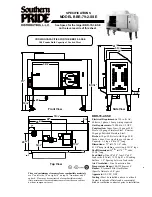
FC200-12-00 8 I56-2214-004R
© 2004 FCI
FCC Statement
This device complies with part 15 of the FCC Rules. Operation is subject to the following two conditions: (1) This device may not cause harmful inter-
ference, and (2) this device must accept any interference received, including interference that may cause undesired operation.
Note: This equipment has been tested and found to comply with the limits for a Class B digital device, pursuant to Part 15 of the FCC Rules. These
limits are designed to provide reasonable protection against harmful interference in a residential installation. This equipment generates, uses
and can radiate radio frequency energy and, if not installed and used in accordance with the instructions, may cause harmful interference to radio
communications. However, there is no guarantee that interference will not occur in a particular installation. If this equipment does cause harm-
ful interference to radio or television reception, which can be determined by turning the equipment off and on, the user is encouraged to try to
correct the interference by one or more of the following measures:
– Reorient or relocate the receiving antenna.
– Increase the separation between the equipment and receiver.
– Connect the equipment into an outlet on a circuit different from that to which the receiver is connected.
– Consult the dealer or an experienced radio/TV technician for help.
ADP-R Intelligent Low-Flow Air Duct Smoke Detector
Installation and Maintenance Instructions
Before installing detectors, please thoroughly read the NEMA
Guide for
Proper Use of Smoke Detectors in Duct Applications,
which provides
detailed information on detector spacing, placement, zoning, wiring,
and special applications. Copies of this manual are available from
NEMA (National Electrical Manufacturers Association, 2101 L Street NW,
Washington, DC 20037). NFPA Standards 72 and 90A should also be ref-
erenced for detailed information.
NOTICE:
This manual shall be left with the owner/user of this equip-
ment.
IMPORTANT:
This detector must be tested and maintained regularly fol-
lowing NFPA 72 requirements. The detector should be cleaned at least
once a year.
General Description
An HVAC system supplies conditioned air to virtually every area of a
building. Smoke introduced into this air duct system is distributed to the
entire building. Smoke detectors designed for use in air duct systems are
used to sense the presence of smoke in the duct.
The ADP-R air duct smoke detector is a photoelectric detector. This smoke
detection method combines with an efficient housing design that samples
air passing through a duct and allows detection of a developing hazardous
condition. When sufficient smoke is sensed, an alarm signal is initiated at
Contents of the Duct Smoke Detector Housing Kit
The ADP-R Duct Smoke Detector consists of the following items
(See Figure 1.):
Figure 1: Exploded View Of Duct Smoke Detector Components
NOTE:
For ducts over 1
1
⁄
2
feet, longer sampling tubes must be ordered to complete the installation. They must be the correct length for the width of
the duct where they will be installed. See Table 1 on page 3 to determine the sampling tube required for different duct widths.
1. Complete duct smoke detector assembly with
sensor
2. Two #10 x 1
1
/
4
″
sheet metal mounting screws
3. Two sampling tube filters
4. One test magnet
5. Drilling template
6. Two foam gaskets
7. Four #6-self tapping mounting screws for the
sampling tube and optional exhaust tube exten
sion
8. One sampling tube end cap
9. One plastic sampling tube
10. One #8 self-tapping screw for plastic sampling
tube
NOTE: A detector sensor board DOES NOT need to
be ordered separately.
Contents Of The Duct Smoke Detector
the fire control panel monitoring the detector, and appropriate action can
be taken to shut off fans, blowers and change over air handling systems,
etc. This can prevent the distribution or it can isolate toxic smoke and fire
gases throughout the areas served by the duct system.
Two LEDs on each detector may illuminate, if programmed by the system
control panel, to provide a local alarm indication. There is also a remote
alarm output for use with auxiliary devices. The ADP-R has remote test
capability with the RTS451/RTS451KEY Remote Test Station. The ADP-R
incorporates a cover tamper feature. When the cover is removed for more
than 20 minutes, the unit loses communication at the panel, a trouble is
indicated at the panel and the alarm relay switches states thereby shutting
down fans, dampers and blowers. In the case when the sensor is removed
or when there is no power to the unit, only a trouble is indicated at the
panel (alarm relay does not work any longer).
WARNING
Limitations of Duct Detectors
The National Fire Protection Association has established that DUCT
DETECTORS MUST NOT BE USED AS A SUBSTITUTE FOR OPEN AREA
DETECTOR PROTECTION as a means of providing life safety. Nor are
they a substitute for early warning in a building’s regular fire detection
system.
FC200-12-00 1 I56-2214-004R
Fire Control Instruments, 16 Southwest Park, Westwood, MA 02090, (781) 487-0088, FAX: (781) 370-4132
FOAM
GASKETS
SAMPLING TUBE
SAMPLING TUBE
FILTERS
DETECTOR
COVER
DETECTOR BOARD
CONDUIT HOLES
DETECTOR
HOUSING
TERMINAL STRIP
POWER BOARD
COVER MOUNTING
SCREWS
Please refer to insert for the Limitations of Fire Alarm Systems
H0129-00






















